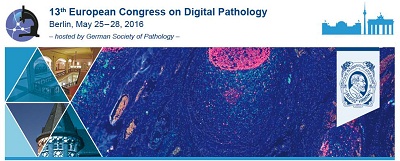Accuracy Of Whole Slide Imaging Stack Alignment In Consecutive Sections Of The Carotid Artery
Abstract
Introduction/ Background
Atherosclerosis is a chronic inflammatory disease of middle-sized and large arteries, characterized by the accumulation of inflammatory cells, especially mac- rophages [1] . A detailed visualization of the presence and distribution of macrophages in the atherosclerotic plaque contributes to a better understanding of the pathogenesis of atherosclerosis and the onset of acute coronary syndromes after atherosclerotic plaque rup- ture. Three-dimensional (3D) reconstruction of histology sections has the potential to improve both the detection of lesions as well as understanding in plaque growth and destabilization.
Aims
The objective of this study is to implement a image marker independent 3D histology reconstruction method in order to visualize the arteriosclerotic vessel and evaluate its accuracy.
Methods
A dataset comprising 48 consecutive cross-sections with a slice thickness of 10µm of a formalin-fixed paraf- fin-embedded (FFPE) carotid artery was used. The slideswere double stained with monoclonal antibodies and were scanned with anOlympusdotSlide scanner with a 10x objective leading to 0.65 micron pixel size. In these images, the smooth muscle cells and macrophages were visualized in blue and red, respectively. Rigid, rigid & affine, and rigid & affine & b-spline (non-rigid) automatic stack alignment was performed using elastix, an open-source toolbox for alignment of images [2]. As a consequence of the image deformation in non-rigid approaches, the diagnostic accuracy might be hindered. Therefore a small bending energy, i.e., sum of the spatial second-order derivatives of the transformation, was al- lowed. In order to increase processing speed, the stack alignment was performed on downsampled data.
Â
An automatically determined mask of the vessel was used for pair-wise reconstruction of the vessel with re- spect to the middle slide that was chosen as a reference section. Accuracy was visually assessed using a surface plot of the lumen of the vessel. In addition, the Dice similarity coefficient, which is a measure of spatial image overlap, of consecutive pairs of slides was calculated for the different stack alignment approaches.
Results
Visual assessment of the surface plot of the vessels’ lu- men after pair-wise stack alignment, showed a relatively smooth surface of the lumen. This was the case for the rigid (i.e. translation and rotation), rigid & affine, and rigid & affine & b-spline approaches.
 The Dice similarity coefficient of the registered masks increased with each additional alignment step. Slides alignment using rigid, rigid & affine and rigid & affine & b-spline approaches resulted in average Dice similarity coefficient of 0.85, 0.87, and 0.98, respectively. A more accurate result of the alignment comes at the cost of an increase in computation time by roughly a factor of two in each additional alignment step.
Downloads
References
[2] Klein S., Staring M., Murphy K., Viergever M.A., Pluim J.P.W., Elastix: a toolbox for intensity based medical image registration, IEEE
Trans Med Imaging 2010, 29(1):196-205.

This work is licensed under a Creative Commons Attribution-ShareAlike 4.0 International License.
Authors who publish with this journal agree to the following terms:
1. Authors retain copyright and grant the journal right of first publication with the work simultaneously licensed under a Creative Commons Attribution License that allows others to share the work with an acknowledgement of the work's authorship and initial publication in this journal.
2. Authors are able to enter into separate, additional contractual arrangements for the non-exclusive distribution of the journal's published version of the work (e.g., post it to an institutional repository or publish it in a book), with an acknowledgement of its initial publication in this journal.
3. Authors are permitted and encouraged to post their work online (e.g., in institutional repositories or on their website) prior to and during the submission process, as it can lead to productive exchanges, as well as earlier and greater citation of published work (See The Effect of Open Access).
4. In case of virtual slide publication the authors agree to copy the article in a structural modified version to the journal's VS archive.








